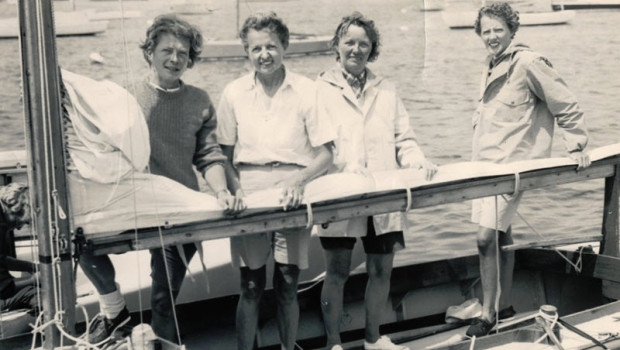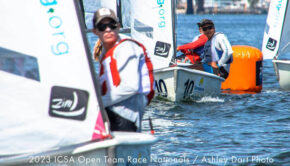Preserving the History of Women in Sailing
Published on February 3rd, 2016
by Deborah Bennett Elfers
A few years ago, I became the captain of our Club’s women’s racing fleet – a much-beloved fleet, indeed, though no one could remember the details of when it had originated. As luck would have it, the Beverly Yacht Club (Marion, MA) happens to be one of the oldest Clubs in the United States, complete with boxes and boxes of archival information documenting its history, and so I began to look through them, hoping to find some clues.
What I learned inspired me.
Back at the turn of the last century, sailing was a spectator sport, with people watching from the shore, and on boats. Weekly races and standings were faithfully reported in the newspaper – and hundreds of these racing accounts had been painstakingly clipped and pasted over the years into the Beverly scrapbooks.
Although there wasn’t a lot of specific information about our fleet or its inception, one of the things I did discover was that women at the helm were not at all uncommon at the very early part of the 1900s, and that at Beverly, they were regularly skippering their own boats in mixed fleets – often winning.
Honestly, I hadn’t expected that. But why would I? Those stories were all but lost, invisible, unless you happened to find yourself sitting in a stiflingly hot attic, looking at a bunch of old books. And that got me to thinking. How much of our women’s sailing history is in danger of being forgotten? What could I learn from those who still remember? And perhaps, most importantly, how can we tell this story together so that it can inspire others?
Still curious, I began a series of informational interviews, gathering as much anecdotal information as I could. What I couldn’t find in the old boxes would have to be supplemented – maybe someone knew something that could help me find out more. What I came away with was the beginnings of an understanding of how differently the world worked just a few generations ago, when sailing was very much a community activity, and parents taught the skill to sons and daughters. There was a continuum.
And I discovered, too, that among those women who were skippering boats in the Club’s racing, there were a number of them who had gone on to win prestigious national championships. And then – quite unexpectedly – I got a letter from the daughter of one of the women who had been a top racer in the 1940s – and with it, a newspaper clipping that led me to the far reaches of the Club, on a treasure hunt, looking for an ancient silver trophy.
And you know what? I found it – and it solved my mystery, establishing the proof that the Beverly Ladies’ Racing Fleet had begun way back in 1925. That trophy, and the fleet’s history, would have been lost had it not been for one person’s insatiable curiosity.
I really enjoyed Molly Mulhern’s recent Scuttlebutt article, Sailing: A Woman’s Place?, in which she wrote: “We sailors don’t know the history of women sailors and their accomplishments nearly as readily as we know of their male counterparts.” And although she was referring to those trailblazing women who had participated in the most demanding of the offshore races, I couldn’t help but think of all the stories we might have lost (or are in danger of losing) that could tell us about the women who have raced and accomplished great things at the Club level.
Those histories need to be woven into the fabric of the whole, because the stories our sailing mothers and grandmothers can tell are the ones that will most powerfully encourage us to take the helm and to stretch our abilities and goals as racers and sailors.
Speaking from my own experience, I’m quite certain that the accomplishments of the women who raced in our fleet in previous generations continue to inspire the women who compete and excel in those same fleets at Beverly today. We look to a higher standard because of them – after all, we’ve got an amazing history, and quite a legacy to live up to.
As Molly suggests, let’s work on getting some of those women’s sailing stories back in print. But let’s also not forget to preserve the history we have right in our own fleets. If you’d like, please contact me with your stories, and help me begin to archive our collective history of women sailors. I have a feeling we’ll have a really big story to tell!
Photo: Beverly racers (from left) Mrs. Sawyer, Mrs. Blanche Gibbs, Mrs. Notman, and Mrs. Colson getting ready to compete for the 1950 Adams Cup. Photo courtesy of Lisa Sawyer.









 We’ll keep your information safe.
We’ll keep your information safe.